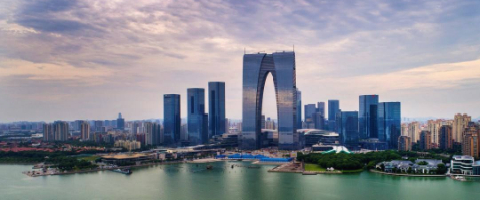

Hello! Welcome to REEI’s second episode of the Energy and Climate Podcast. (Spotify; Apple Podcasts; Google Podcasts). In this episode, we bring you our commentary on the report : Optimisation of Suzhou’s Carbon Emissions Peak Roadmap and A Long-term Vision for 2050 that was jointly written by the World Resources Institute (WRI) China and the School of Environment at Nanjing University.
A brief introduction to Suzhou City: Suzhou is located in the Yangtze River Delta, and famous for its classical Chinese gardens. The city lies between Shanghai and Lake Tai, which is the third largest freshwater lake in China. The area of Suzhou is about the same as that of Shanghai. Suzhou’s GDP in 2019 reached nearly two trillion Chinese Yuan, ranking sixth among all Chinese cities. Before its industrial transformation and upgrading, the manufacturing sector had long been the major contributor to Suzhou’s GDP. Now, however, the major contributor to Suzhou’s GDP is the tertiary industry.
Through our commentary you will learn:
1). Will Suzhou’s industrial transformation have an impact on the city’s carbon emissions? Positive or negative? (01:51-02:09)
2). Why is Suzhou reducing its carbon emissions? Why does Suzhou want to peak its carbon emissions? (02:25-03:56)
3). An overview of the report by the WRI and Nanjing University (04:00-04:57)
4). What are the ‘2020 scenario’ and the ‘2050 vision’? What is the optimised approach for achieving the 2050 vision? (05:00-07:22)
5). The difference in carbon emissions between the scenarios in 2020 and 2050. (07:25-08:23)
6). What are the conclusions and the policy recommendations of the report? (08:35-10:20)
7). What are the limitations of the report? (10:30-11:20)
8). The performance of other cities that are of a similar-sized population, economy and similar industrial structure to Suzhou in reducing carbon emissions. What can they learn from Suzhou’s situation to reduce their own carbon emissions? (11:30-13:35)
------------------------------------------------------------------------------------------------------------
Response from the authors: The Peaking of Suzhou City’s Carbon Emission and the Low-carbon Pathway Toward 2050
We sent through our five questions to the authors whose report we interpretated in our last episode. We are glad that we have received a reply from the authors with The World Resources Institute China’s kind help(Spotify; Apple Podcasts; Google Podcasts). We translated the authors’ answers from Chinese into English.
We are asking:
Q1: What is the impact of COVID-19 on when Suzhou’s carbon emissions peak and its carbon emissions after 2020? (0:15-02:57)
Q2: What would the role of carbon pricing be when Suzhou is decarbonizing? (02:57-04:22)
Q3: Why do energy-intensive industries with low output value still exist in Suzhou? What’s action is the government taking to address this issue? How does the government in Suzhou view their role in its carbon emission peak roadmap? (04:24-07:00)
Q4: How do the authors view the relationship between economic growth and carbon emission decoupling? (07:03-07:53)
Q5: Which policies of the central or local governments contribute most to the realization of peak carbon emissions in Suzhou? (07:56-10:04)
*If you have questions about the report or anything else, please contact Yating Yuan (yuanyating@reei.org.cn).
Note: Climate Watch updated data after the completion of recordings. As of 23rd of September, there are 39 countries have submitted long-term strategies to the UNFCCC, accounting for 26.5 % of the global carbon emissions.




